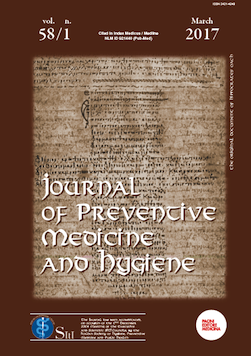Abstract
Introduction: We have found clusters of K. pneumoniae with OXA48-carbepenemase cases in some hospital rooms. We decided to investigate whether the bathroom siphons could be a reservoir for OXA48 bacteria by experimental and clinical follow of patients in two clinical Services in a tertiary hospital
Methods: Determination of the âmicrobial competitionâ between strains with OXA48 and VIM carbepenemases, âdissemination capacityâ of K. pneumoniae with carbepenemase OXA48 or VIM, from hands to standard surfaces and âEpidemiological and microbiological studiesâ of patients and the sink in their rooms, in two Services of our hospital: Traumatology and Oncology.
Results and discussion: Microbial competition studies showed that VIM-bacteria are inhibited by OXA-bacteria. We found a grand possibility of diffusion from contaminated hands, but it was more intense in OXA than VIM bacteria. These observations can explain the concentration of cases of OXA48-K. pneumoniae in some rooms in Traumatology and Oncology. The Risk-ratio was >3 between rooms with OXA48-bacteria-contaminated siphons and the other rooms. This risk was lowered after changing or disinfecting (heat plus chlorinated disinfectant) the contaminated siphons.
In conclusion, bathroom siphons can be a reservoir of OXA48-K. pneumoniae and lead to outbreaks, which can be controlled by change (or heat plus chemical treatment) of the sink-siphons.
References
Paño-Pardo JR, Ruiz-Carrascoso G, Navarro C et al. Infections caused by OXA-48-producing Klebsiella pneumoniae in a tertiary hospital in Spain in the setting of a prolonged, hospital-wide outbreak. J Antimicrob Chemother 2013 ; 68:89â96.
Lowe C, Willey B, OâShaughnessy A et al. Outbreak of Extended-Spectrum β-Lactamaseâproducing Klebsiella oxytoca Infections Associated with Contaminated Handwashing Sinks. Emerg Infect Dis 2012; 18: 1242-1247.
Vergara-Lopez S, Domınguez MC, Conejo MC et al. Wastewater drainage system as an occult reservoir in a protracted clonal outbreak due to metallo-b-lactamase-producing Klebsiella oxytoca. Clin Microbiol Infect 2013; 19: 490-498
Scotta C, Juan C, Cabot G et al. Environmental Microbiota Represents a Natural Reservoir for Dissemination of Clinically Relevant Metallo-B-Lactamases Antimicrob Agents Chemother 2011; 55 :5376-5379.
Otter JA, Yezli S, Salkeld JAG et al. Evidence that contaminated surfaces contribute to the transmission of hospital pathogens and an overview of strategies to address contaminated surfaces in hospital settings. Am J Infect Control 2013; 41: S6-S11
Huang SS, Datta R, Platt R. Risk of acquiring antibiotic-resistant bacteria from prior room occupants. Arch Intern Med 2006; 166:1945-1951.
Drees M, Snydman D, Schmid C et al. Prior environmental contamination increases the risk of acquisition of vancomycin resistant enterococci. Clin Infect Dis 2008; 46: 678-685.
Nseir S, Blazejewski C, Lubret R et al. Risk of acquiring multidrug-resistant gram-negative bacilli from prior room occupants in the intensive care unit. Clin Microbiol Infect 2011; 17: 1201-1208.
Shaughnessy MK, Micielli RL, DePestel DD et al. Evaluation of hospital room assignment and acquisition of Clostridium difficile infection. Infect Control Hosp Epidemiol 2011; 32:201-206.
Datta R, Platt R, Yokoe DS et al. Environmental cleaning intervention and risk of acquiring multidrug-resistant organisms from prior room occupants. Arch Intern Med 2011; 171: 491-494.
Hota B. Contamination, Disinfection, and Cross-Colonization: Are Hospital Surfaces Reservoirs for Nosocomial Infection? Clin Infect Dis 2004; 39: 1182â9
Carling PC, von Bheren S, Kim P, et al. Intensive care unit environmental cleaning: an evaluation in sixteen hospitals using a novel assessment tool. J Hosp Infect 2008; 68:39-44.
Carling P. Methods for assessing the adequacy of practice and improving room disinfection. Am J Infect Control 2013; 41 : S20-S25
Peleg AY, Hooper DC. Hospital-acquired infections due to gramnegative bacteria. N Engl J Med 2010; 362: 1804-1813.
Siegel JD, Rhinehart E, Jackson M et al. 2007 Guideline for Isolation Precautions: Preventing Transmission of Infectious Agents in Healthcare Settings. 2007 CDC.
Havill NL . Best practices in disinfection of noncritical surfaces in the health care setting: Creating a bundle for success. Am J Infect Control 2013; 41 : S26-S30
Donskey CJ. Does improving surface cleaning and disinfection reduce health care-associated infections? Am J Infect Control 2013; 41: S12-S19
Herruzo R, Vizcaino MJ, Herruzo I. Quantifying Glosair 400 ® efficacy for surface disinfection of ATCC and microorganisms recently isolated from ICU patients. J Hosp Infect 2014; 87: 175-178
Kramer A, Schwebke I, Kampf G. How long do nosocomial pathogens persist on inanimate surfaces? A systematic review. BMC Infec Dis 2006; 6:130-138.

